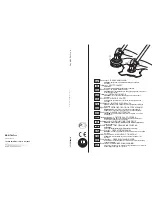
22
SC2560 & SC2572 Skid Steer Rotary Cutter 326-836M
1/15/21
Section 3: Operating Procedures
Operating Checklist
Hazard control and accident prevention are dependent
upon the awareness, concern, prudence, and proper
training involved in the operation, transport, storage, and
maintenance of the Rotary Cutter. Therefore, it is
absolutely essential that no one operates the Rotary
Cutter without first having read, fully understood, and
become totally familiar with the Operator’s Manual. Make
sure the operator has paid particular attention to:
•
•
•
•
Section 3: Operating Procedures,
•
Section 5: Maintenance & Lubrication,
The following inspections should be performed before
operating your Skid Steer cutter.
Safety Information
DANGER
!
Hydraulic fluid under high pressure can penetrate skin. Wear
protective gloves and safety glasses or goggles when working
with hydraulic systems. Use a piece of cardboard or wood
rather than hands when searching for hydraulic leaks. If
hydraulic fluid is injected into the skin or eyes, it must be
treated by a doctor familiar with this type of injury within a
few hours or gangrene may result. DO NOT DELAY.
DANGER
!
Keep others away while cutter is operating. It can discharge
objects at high speeds. Therefor, the use of front and rear
safety guards is required when cutting along highways and in
areas where people may be present. Stop blade rotation if a
bystander is within several hundred feet.
DANGER
!
Do not use cutter as a fan. Cutting blades are not properly
designed or guarded for this use. Using cutter as a fan can
DANGER
!
Do not cut on steep inclines. The Skid Steer could flip over
causing damage to the equipment, serious injury or death.
Operating Checklist
Check
Ref.
Make sure all guards and shields are in place and
secure.
Inspect hydraulic hoses for wear, damage, and
hydraulic leaks. Replace damaged or worn hoses
with genuine Land Pride parts.
Grease all fittings. Refer to “Lubrication Points”
Check Rotary Cutter initially and periodically for
loose bolts & pins, See “Torque Values Chart”.
DANGER
!
Do not operator cutter with cutting blades raised higher than
18" off the ground. Always use height adjusting safety chain to
limit cutting height to 18" (16 1/2" skid shoe height). Raising
the cutter higher can throw debris at the operator and cause
DANGER
!
Shields must be secured in place when operating to avoid
DANGER
!
Do not operate cutter without an Operator Protective Door
mounted to the cab and protective eye wear such as safety
glasses or goggles. Flying objects from the cutter can cause
serious injury to the body and eyes.
WARNING
!
Do not become entangled in the hydraulic hoses. Tripping
over the hoses while entering or exiting the Skid Steer
operator station can cause serious injury to the body.
WARNING
!
Do not travel too fast. The rougher the terrain, the slower you
must travel. Always travel at a speed slow enough to be able
to adjust the deck height before running it into the ground.
Remember, sudden dropping of the front tires can slam the
deck into the ground. Also, travel slow enough to stop before
running or turning into obstacles ahead and on either side.
WARNING
!
Do not use cutter to lift or carry objects, to pull fence posts,
stumps or other objects, or to tow other equipment. Doing so
can damage the cutter, cause serious bodily injury or death.
WARNING
!
Never allow riders including children on the tractor or cutter.
They can fall and be ran over causing serious injury or death.
WARNING
!
Do not use deck as a working platform. The deck is not
properly designed or guarded for this use. Using deck as a
working platform could cause serious injury or death.
CAUTION
!
Do not exceed rated cutting capacity of your cutter. See
specifications & capacities for specified cutting capacity.
Exceeding ratted cutting capacities can damage drive
components, cutter blades, and deck components.
CAUTION
!
Do not cut after dark without working lights. The equipment
can be damaged from hitting objects not seen in the dark and
from being hit by vehicles not able to see the equipment.
Section 3: Operating Procedures
















































